
Capitol Records: 1976 Reissue
#08 Help! (SMAS-2386)
(Update: 14th July 2025)



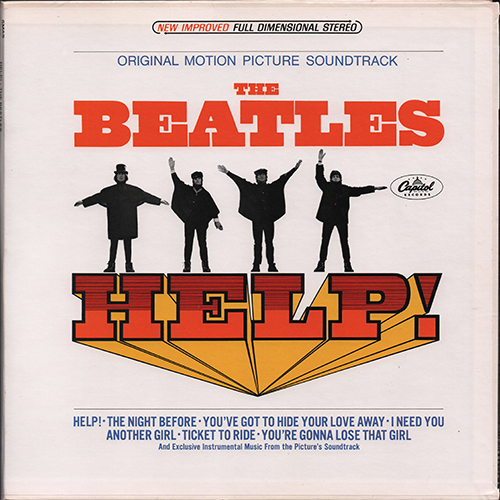 Capitol 1st. Sleeve |
|
|
TITLE
|
HELP! |
||||
| CATALOG
NUMBER |
SMAS-2386 |
||||
|
RELEASE DATE
|
1976 / First Press |
||||
| TITLE LISTING |
SIDE
1 |
SIDE
2 |
|||
| Help! (BMI-2:35) |
Another Girl
(BMI-2:02) |
||||
| The Night Before
(BMI-2:33) |
Another Hard
Day's Night (BMI-2:28) |
||||
| From Me To You
Fantasy (BMI-2:03) |
Ticket To Ride
(BMI-3:03) |
||||
| You've Got To
Hide Your Love Away (BMI-2:08) |
The Bitter End
(BMI-2:20) You Can't Do That (BMI) |
||||
| I Need You
(BMI-2:28) |
You're Going To
Lose That Girl (BMI-2:18) |
||||
| In The Tyrol (BMI-2:21) | The Chase (BMI-2:24) | ||||
| FRONT--> Click! | BACK --> Click! | SIDE 1 --> Click! | SIDE 2 --> Click! | DISK --> Click! | |
 |
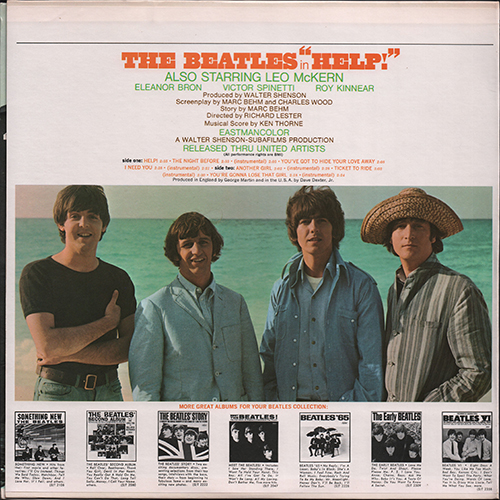 |
 |
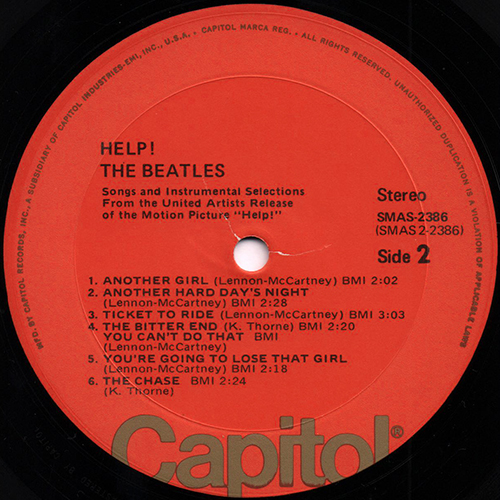 |
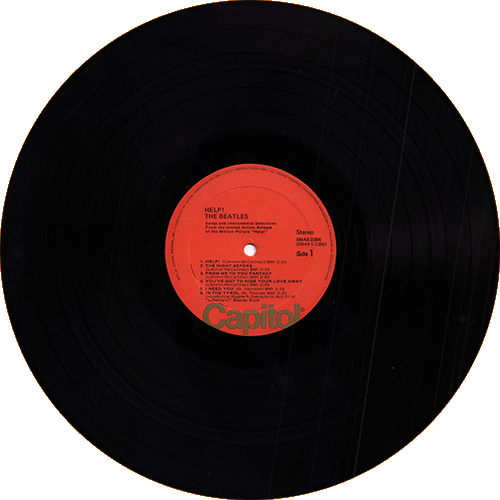 |
|
| INSIDE--> Click! | INNER SLEEVE | ||||
| FRONT --> Click | BACK --> Click! | Plain white inner
sleeve. |
|||
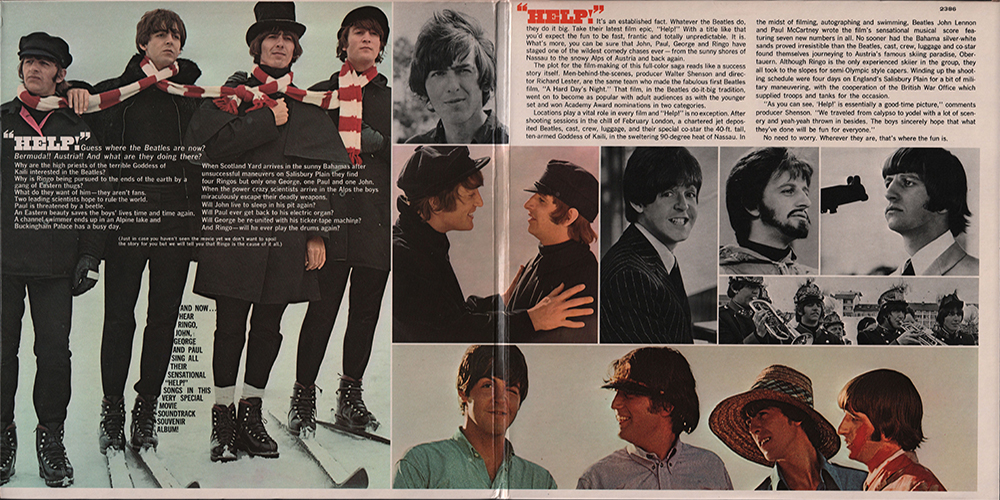 |
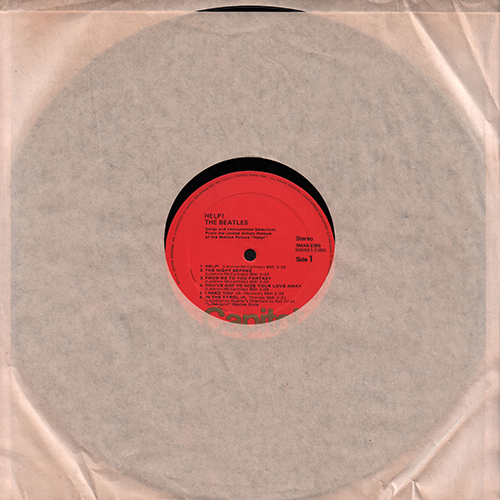 |
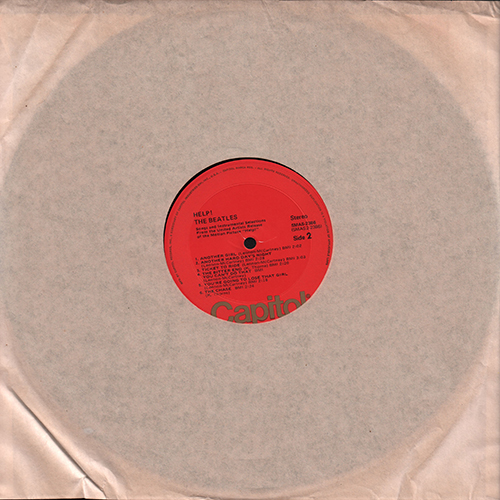 |
|||
| FRONT COVER CLOSE UP | |||||
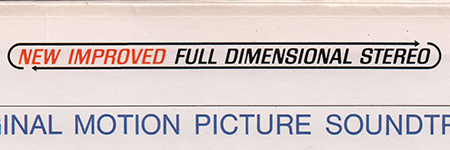 |
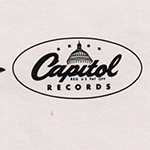 |
The customary “File Under,” black dot and
record number information is missing. On the stereo album cover the outside slick is positioned to show the New Improved Full Dimensional Stereo logo at the top. |
|||
| BACK COVER CLOSE UP | INSIDE CLOSE UP | SPINE CLOSE UP | |||
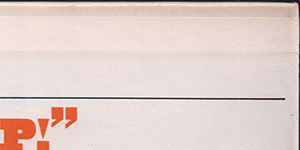 |
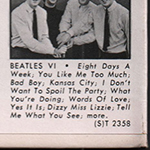 |
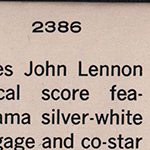 |
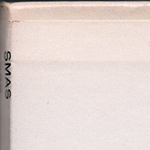 |
||
| The High Fidelity Recording logo, "Also available in stereo" in uppercase letters, and Capitol / EMI logo mark were NOT printed. | RIAA (Record Industry Association of America" logo and factory code number were NOT printed. | Catalog number "2386" was
printed at the upper right corner on the inside of the album
cover. |
Album cover has the mono
number (SMAS 2386) at the top of the spine. |
||
| BACK COVER CLOSE UP | |||||
 |
"Produced in the U.S.A. by Dave Dexter, Jr."
was printed on the back cover. |
||||
| LABEL CLOSE UP | |||||
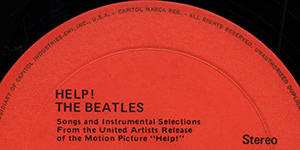 |
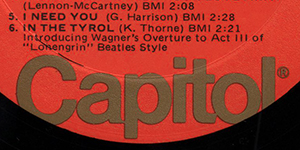 |
The Capitol label is replaced with a
bright orange label with “Capitol” written in goldish-tan
letters at the bottom of the label. The rim text is at the
top of the label. |
|||
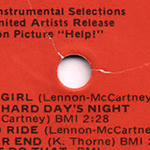 |
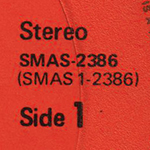 |
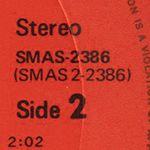 |
 |
||
| Catalog number and master number
were printed at the right side of the center hole. "Mfd. by Capitol Records, Inc." is printed at the perimeter. |
|||||
| LABEL CLOSE UP | |||||
| SIDE 1 |
SIDE 2 |
The earlier orange
label pressing is identified with "Side 1" and "Side 2" on
the right, as opposed to later pressings with the large 1
and 2 on the left side. (maybe) |
|||
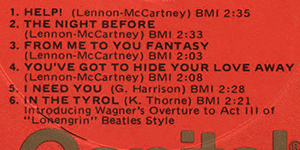 |
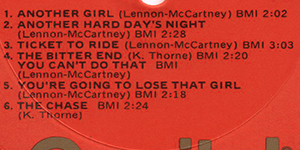 |
||||
 |
The fourth track on side two is listed as a combination of Ken Thorne's "The Bitter End" and a jazz arrangement of Lennon and McCartney's "You Can't Do That." | ||||
|
OTHER ITEM
|
|||||
| - | |||||
| LABEL | Capitol
Orange Label type-3-1 (with All Rights Reserved) |
||||
| MIX | STEREO |
||||
| VINYL COLOR | Black |
||||
| PRESS FACTORY |
SLEEVE | West
Coast: Bert-Co Enterprise of Los Angeles |
|||
| VINYL | Los
Angeles, California |
||||
| FACTORY CODE | - |
||||
| MATRIX No. | SIDE 1 |
SMAS-1-2386-G23
(hand etched) 1 * MASTERED
BY CAPITOL (machine stamped) |
|||
| SIDE 2 |
SMAS-2-2386-H20
(hand etched) 1 *
MASTERED BY CAPITOL (machine stamped) |
||||
| RECORD COMPANY'S NAME | Mfd. by Capitol Records, Inc.,
/ (P) Capitol Records. Inc |
||||
| PUBLISHER'S NAME |
- |
||||
|
"SUBSIDIARY" PRINT
|
Yes |
||||
| COVER FORM |
Gatefold
type. Housed in a cardboard jacket. |
||||
| INNER SLEEVE | Plain
white inner sleeve |
||||
| COVER DESIGN/ PHOTO/ NOTES | Photo:
Robert Freeman |
||||
| PRODUCER | Produced
in England by George Martin and in the U.S.A. by Dave
Dexter, Jr. |
||||
|
COMMENTS
|
1976 reissue with Orange Capitol
label and with the Gold Record Award by RIAA on front cover. Positioned to reveal the Capitol Full Dimensional Stereo arrow logo at the top. No phrase "File Under: The Beatles • Pop Rock, Vocal Group" Label rim text includes "All Rights Reserved" statement. Orange Capitol Label Type-1: In October, 1972, Capitol left the "red label" behind after pressing it for under two years. The new design was an orange label with “Capitol” at the bottom. Since all Beatles albums were being pressed on the Apple label during 1972-1975, there are no Beatles records on the first or second orange label. This first style used the same rim print from the earlier labels, ending with the patent number for T-Rim. Type-2: In October, 1973, Capitol removed “US PAT NO” and the patent number for T-Rim and centered the rim print better on the label. Type-3: In September, 1975, Capitol added a lengthy "All Rights Reserved" saying to all their albums. The Beatles/solo catalog remained on the Apple label until January, 1976; after this the orange label was used for Beatles-related reissues. Therefore, the whole LP catalog was transferred to the orange Capitol label with "All Rights Reserved." This label style remained until February 1978. The earlier orange label pressing is identified with "Side 1" and "Side 2" on the right, as opposed to later pressings with the large 1 and 2 on the left side. (maybe) |
||||
|
TITLE
|
HELP! |
||||
| CATALOG
NUMBER |
SMAS-2386 |
||||
|
RELEASE DATE
|
1977? / Second Press |
||||
| TITLE LISTING |
SIDE
1 |
SIDE
2 |
|||
| Help! (BMI-2:35) |
Another Girl
(BMI-2:02) |
||||
| The Night Before
(BMI-2:33) |
Another Hard
Day's Night (BMI-2:28) |
||||
| From Me To You
Fantasy (BMI-2:03) |
Ticket To Ride
(BMI-3:03) |
||||
| You've Got To
Hide Your Love Away (BMI-2:08) |
The Bitter End
(BMI-2:20) You Can't Do That (BMI) |
||||
| I Need You
(BMI-2:28) |
You're Going To
Lose That Girl (BMI-2:18) |
||||
| In The Tyrol (BMI-2:21) | The Chase (BMI-2:24) | ||||
| FRONT--> Click! | BACK --> Click! | SIDE 1 --> Click! | SIDE 2 --> Click! | DISK --> Click! | |
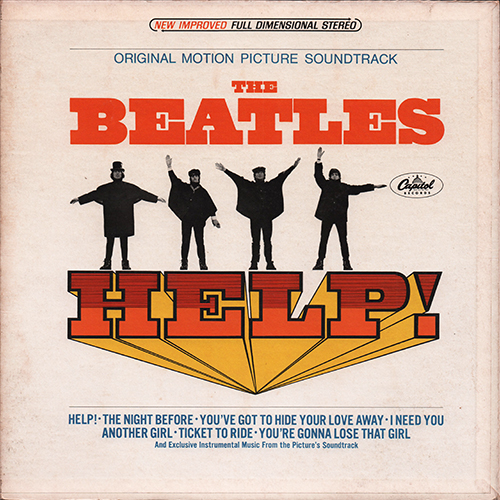 |
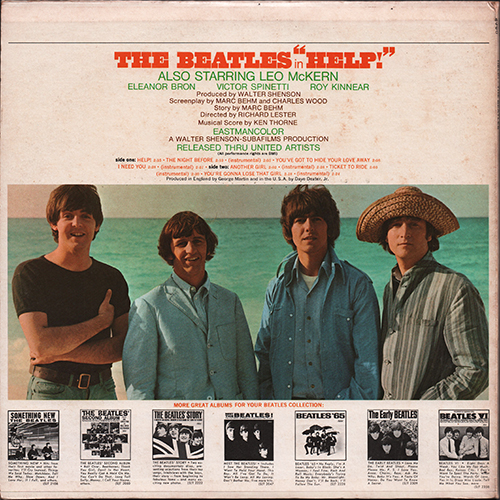 |
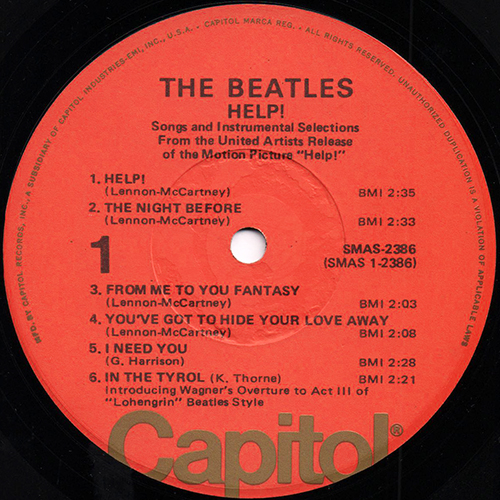 |
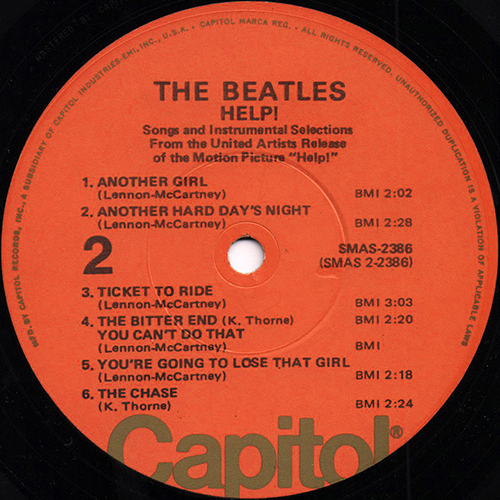 |
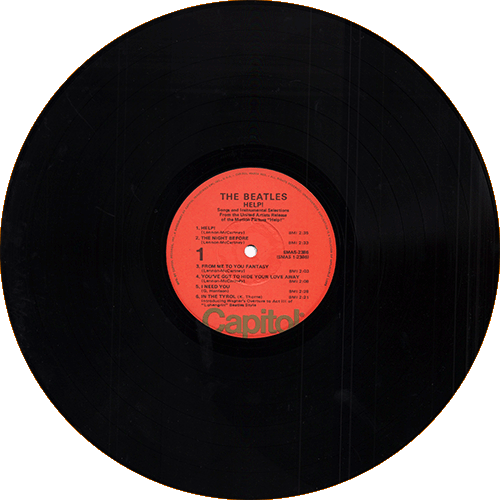 |
|
| INSIDE--> Click! | INNER SLEEVE | ||||
| FRONT --> Click | BACK --> Click! | Plain white inner
sleeve. |
|||
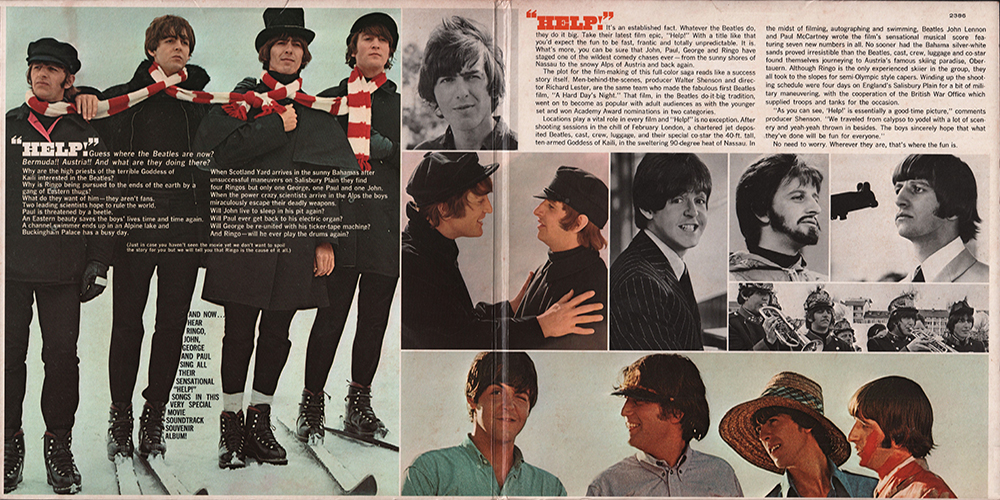 |
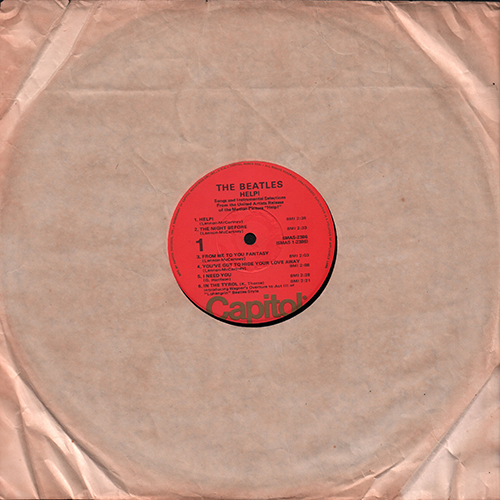 |
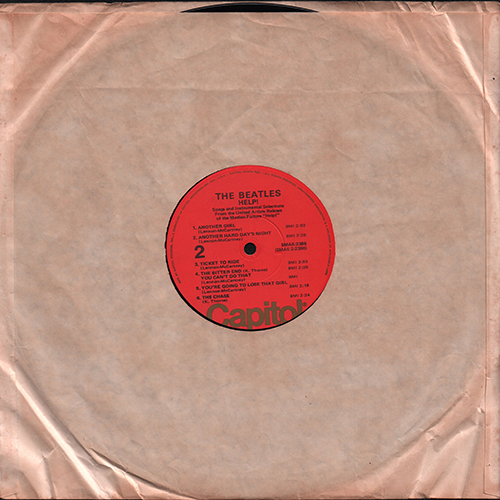 |
|||
| FRONT COVER CLOSE UP | |||||
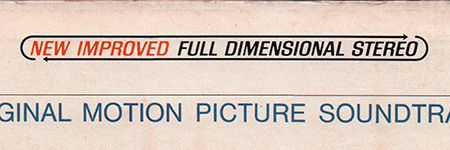 |
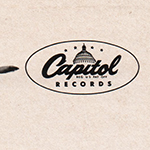 |
The customary “File Under,” black dot and
record number information is missing. On the stereo album cover the outside slick is positioned to show the New Improved Full Dimensional Stereo logo at the top. |
|||
| BACK COVER CLOSE UP | INSIDE CLOSE UP | SPINE CLOSE UP | |||
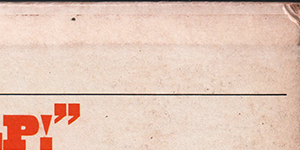 |
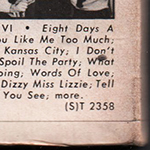 |
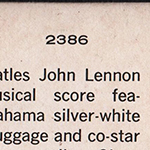 |
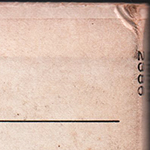 |
||
| The High Fidelity Recording logo, "Also available in stereo" in uppercase letters, and Capitol / EMI logo mark were NOT printed. | RIAA (Record Industry Association of America" logo and factory code number were NOT printed. | Catalog number "2386" was
printed at the upper right corner on the inside of the album
cover. |
Album cover has the mono
number (SMAS 2386) at the top of the spine. |
||
| BACK COVER CLOSE UP | |||||
 |
"Produced in the U.S.A. by Dave Dexter, Jr."
was printed on the back cover. |
||||
| LABEL CLOSE UP | |||||
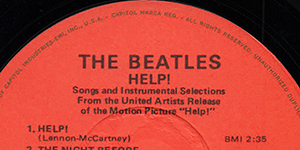 |
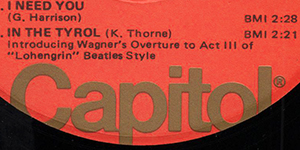 |
The Capitol label is replaced with a
bright orange label with “Capitol” written in goldish-tan
letters at the bottom of the label. The rim text is at the
top of the label. |
|||
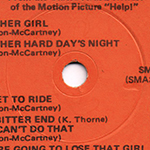 |
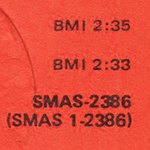 |
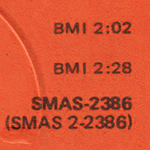 |
 |
||
| Catalog number and master number
were printed at the right side of the center hole. "Mfd. by Capitol Records, Inc." is printed at the perimeter. |
|||||
| LABEL CLOSE UP | |||||
| SIDE 1 |
SIDE 2 |
The earlier orange
label pressing is identified with "Side 1" and "Side 2" on
the right, as opposed to later pressings with the large 1
and 2 on the left side. (maybe) |
|||
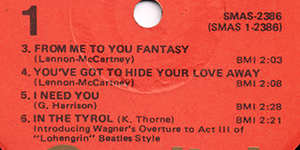 |
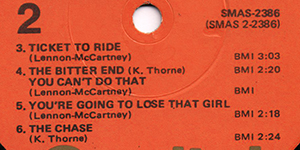 |
||||
 |
The fourth track on side two is listed as a combination of Ken Thorne's "The Bitter End" and a jazz arrangement of Lennon and McCartney's "You Can't Do That." | ||||
 |
In September, 1975, Capitol
added a lengthy "All Rights Reserved" saying to all their
albums. The Beatles/solo catalog remained on the Apple
label until January, 1976; after this the orange label was
used for Beatles-related reissues. Therefore, the whole LP
catalog was transferred to the orange Capitol label with "All
Rights Reserved." This label style remained until
February 1978. |
||||
|
OTHER ITEM
|
|||||
| - | |||||
| LABEL | Capitol
Orange
Label type-3-2 (with All Rights Reserved) |
||||
| MIX | STEREO |
||||
| VINYL COLOR | Black |
||||
| PRESS FACTORY |
SLEEVE | West
Coast: Bert-Co Enterprise of Los Angeles |
|||
| VINYL | Los
Angeles, California |
||||
| FACTORY CODE | - |
||||
| MATRIX No. | SIDE 1 |
SMAS-1-2386-H-24
Jay (hand etched) 2 * MASTERED BY
CAPITOL (machine stamped) |
|||
| SIDE 2 |
SMAS-2-2386-H-20
(hand etched) 3 *
MASTERED BY CAPITOL (machine stamped) |
||||
| RECORD COMPANY'S NAME | Mfd. by Capitol Records, Inc.,
/ (P) Capitol Records. Inc |
||||
| PUBLISHER'S NAME |
- |
||||
|
"SUBSIDIARY" PRINT
|
Yes |
||||
| COVER FORM |
Gatefold
type.
Housed in a cardboard jacket. |
||||
| INNER SLEEVE | Plain
white inner sleeve |
||||
| COVER DESIGN/ PHOTO/ NOTES | Photo:
Robert
Freeman |
||||
| PRODUCER | Produced
in
England by George Martin and in the U.S.A. by Dave Dexter,
Jr. |
||||
|
COMMENTS
|
1976 reissue with Orange Capitol
label and with the Gold Record Award by RIAA on front cover. Positioned to reveal the Capitol Full Dimensional Stereo arrow logo at the top. No phrase "File Under: The Beatles • Pop Rock, Vocal Group" Label rim text includes "All Rights Reserved" statement. Orange Capitol Label Type-1: In October, 1972, Capitol left the "red label" behind after pressing it for under two years. The new design was an orange label with “Capitol” at the bottom. Since all Beatles albums were being pressed on the Apple label during 1972-1975, there are no Beatles records on the first or second orange label. This first style used the same rim print from the earlier labels, ending with the patent number for T-Rim. Type-2: In October, 1973, Capitol removed “US PAT NO” and the patent number for T-Rim and centered the rim print better on the label. Type-3: In September, 1975, Capitol added a lengthy "All Rights Reserved" saying to all their albums. The Beatles/solo catalog remained on the Apple label until January, 1976; after this the orange label was used for Beatles-related reissues. Therefore, the whole LP catalog was transferred to the orange Capitol label with "All Rights Reserved." This label style remained until February 1978. The earlier orange label pressing is identified with "Side 1" and "Side 2" on the right, as opposed to later pressings with the large 1 and 2 on the left side. (maybe) Jay Maynard: Mastering Engineer known to have worked at Capitol Mastering Known runout etchings: 1976 Later on commonly Jay or JAY was used (written in cursive so may appear as JAM) |
||||